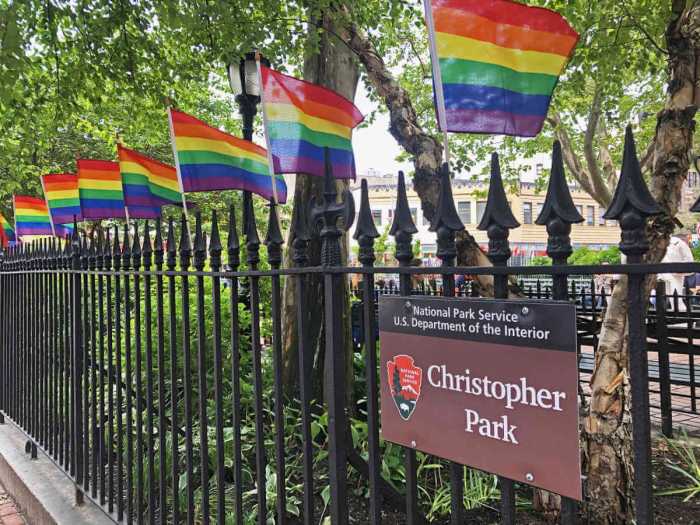Three California Men Charged in Brutal 2002 Gwen Araujo Slaying
On Wednesday, a year and a half after the crime, a criminal trial finally began in the case of the three men charged with the murder of Newark, California transgendered teenager Gwen Araujo.
After a month of eliminations which whittled a pool of 400 down to twelve jurors and four alternates, the courtroom, packed with Araujo’s family and friends, sat silent as prosecutor Chris Lamiero quietly recounted his version of what happened late in the night of October 3, 2002 when four young Newark men, he said, after a night of drinking, verbally abused, bludgeoned, tortured, and finally strangled the 17-year-old teen to death.
In Newark, a heavily Latino city about 30 minutes southeast of San Francisco, the case has opened a public dialogue about tolerance and homophobia in the city and its schools, but nationally, the case promises to become the Matthew Shepard of the transgender rights movement both because of the brutality of the killing and the youth of the victim.
Lamiero said that two of the men, José Merel, 24, and Michael Magidson, 23, previously had sex with Araujo, who was born Edward, and called herself Gwen, but was known to the alleged murderers only as a girl named Lida.
Prosecutors charge that on the night of the murder, when they discovered Araujo was not the girl they thought she was, but was biologically a male, Merel and Magidson began a systematic and cold-blooded ordeal of beatings and torture that left Araujo dead. Just who, exactly, contributed the death blow will be a major point of contention in what promises to be a lengthy trial.
But there is little argument that Merel, Magidson and their friends Jaron Nabors, now 21, and Jason Cazares, 24, drove the bloody body to a remote campground about 150 miles northeast in the Sierra Nevada mountains, dug a shallow grave, placed Araujo’s body in it, piled boulders on top of it, “to keep animals from dismembering it,” Lamiero said, and then tried to disguise the grave with brush and leaves.
On the trip back from the mountains, the sun was rising as they crossed California’s central valley, and the four, jammed into the front of Magidson’s pick-up truck, made a pact not to tell anyone about what they had done.
That pact lasted only until the next afternoon, when Nabors told his friend Adam Hewson about the events of the night before. After word of the murder spread through the city of 43,000, back to Araujo’s family and finally to police, Hewson went back to Nabors to ask him to repeat what had happened––this time wearing a recorder provided by the police. On October 16, 13 days after the crime, a thoroughly cowed Nabors led police to the grave.
During the preliminary hearing a year ago, Nabors pled guilty to voluntary manslaughter and testified against his former friends in exchange for an 11-year prison term. Nabors will be the prosecution’s star witness, because while others saw and heard the preliminary exchanges between the four and Araujo, Nabors is the only person not on trial who saw the alleged murder.
Lamiero’s opening argument went on for two and a half hours, so, of the three defense counsels, only famed defense attorney Tony Serra, who is representing Cazares, was able to speak Wednesday. Serra, famous in part because of his impassioned defense of medical marijuana growers, immediately launched into an attack on Nabors’ credibility, charging that he had been browbeaten by prosecutors into implicating all three defendants, including his client who, Serra maintained, initially tried to defend Araujo before finally going along with his friends to bury the body.“Without him, there would be no case against my client,” Serra said.
Also known for his thrift shop suits and long flowing white hair, Serra said Nabors was told by prosecutors to deliver evidence of murder against all of them in exchange for his reduced sentence.
“Ladies and gentlemen of the jury, he got away with murder… and he’s an expert liar,” Serra said.
Serra said he would put his client, Cazares, on the stand to refute Nabors’ testimony.
Serra moved to discredit a letter which Nabors sent to his girlfriend from jail, which implicated Cazares, as a deliberate attempt to lump Cazares with the other alleged murderers, who had already been arrested in the hope that he, Nabors, would be offered a deal. Serra said that Nabors knew it would be opened by police.
Serra also asserted that Nabors too had had sex with Araujo.
But there seems to be less doubt about the remaining pair’s role in the crime. During jury selection Magidson’s lawyer, Michael Thorman, suggested that he might try to show that his client acted in a fit of rage––and is therefore eligible for a reduced charge of manslaughter. So the exact timing of the events will become a major issue in the trial. Prosecutor Lamiero has characterized the night as a drawn-out deliberate series of beatings and finally murder, but Serra said that the four may have acted much more quickly.
According to prosecutor Lamiero, the four went to the Merel house that had, since Merel’s parents had moved out, become a venue for late night parties. They got to the house at about 2 a.m. after a night of drinking at two local bars. Araujo was already there when they arrived, along with José Merel’s brother Paul, Paul’s girlfriend, Nicole Brown, and José’s younger brother Emmanuel.
According to Lamiero, the group had discussed, on several occasions, some doubt about Araujo’s gender, and decided that this was the night to find out. They said her hair was coarse, like a man’s, her voice was “scratchy,” she often wore clothes that concealed her neck, and while both José Merel and Magidson had had sex with Araujo, on both occasions she had refused vaginal sex, saying she was having her period, despite the fact that the incidents were two weeks apart.
The four men, Brown, and Araujo, according to Lamiero, all sat at the home’s dining table and the men started quizzing Araujo about her gender. Finally Brown went with Araujo to the bathroom where she reached under Araujo’s skirt and discovered that Araujo was biologically a male.
“For José,” Lamiero said, “what he found was an insult to his very fragile and insecure sense of masculinity. For José, it would demand revenge.” José started crying, and yelled, “I can’t be gay, I can’t be fuckin’ gay.”
According to Lamiero, Nicole Brown will testify that she saw Magidson punch Araujo twice in the face. Brown threatened to call the police. Magidson and Nabors began to choke her. Emmanuel Merel came out and tried to push Araujo out the door, but couldn’t because Magidson and Nabors were standing by it. Magidson again tried to strangle her, and Cazares pulled his friend off of Araujo.
While Magidson held Araujo up, José went into the kitchen, got a tin of food and smashed it on Araujo’s head. He then went back to the kitchen, got a skillet, and hit her again, this time on the forehead.
“It was clear that at this point, we have crossed the Rubicon. We have passed the point of no return,” said Lamiero, as Araujo’s mother, Sylvia Guerrero, who was in the courtroom, closed her eyes.
José Merel’s brothers, Paul and Emmanuel, along with Paul’s girlfriend, Nicole Brown, all left the house. Emmanuel went to spend the night at a neighbor’s house. Paul Merel and Brown drove away, but had second thoughts, went around the block, and returned to the front of the house, where they encountered, Cazares and Magidson, according to Brown, driving away in Magidson’s truck. She asked where they were going.
According to Brown they said, “We’re going to my house to get some shovels and kill that bitch.”
According to the prosecutor’s description of Araujo’s final moments, Nabors contends that Magidson punched Araujo twice in the face after Cazares had encouraged him by saying, “Knock that bitch out.” Lamiero said that Magidson then drove his knee into her face, and cracked the plaster on the wall behind her with her head.
“Her last memory was seeing Magidson drive his knee into her head,” said Lamiero. In the courtroom, Guerrero began weeping.
Nabors, Cazares and Magidson carried Araujo into the garage where, according to Lamiero, Magidson strangled her with a piece of rope. They then loaded the body into the truck and set off for the Sierras.
In front of the courthouse, after the opening arguments, civil rights attorney Gloria Allred, who is representing Sylvia Guerrero, said that she was sure that “the decision to kill was made long before the tragedy” and so would demand a verdict of premeditated murder.
Allred called Serra’s objections “the classic ‘some other dude did it,’” defense. But at the top of his statement, Lamiero said that trials develop lives of their own, and this one is expected to last at least until the middle of June.
Of the twelve jurors from Hayward, just across the bay from San Francisco where the trial is being held, eight are college graduates. Eleven of the twelve know someone who is gay, lesbian, or bisexual. Four said they have known someone who is transgendered. The youngest is 32. The oldest is 63. Two are black, one is Asian, the rest are white.
But come trial’s end, they will have heard from all the witnesses to the crime, including at least one of the defendants, Cazares, and will have been to the scene of the crime, and probably to the grave site.
For Cazares’ case, Serra said the trial will be a contest of credibility between Cazares and Nabors. But for the other two, the jury will probably be asked whether it is OK to kill someone who you say has lied to you about their gender.
We also publish:




































